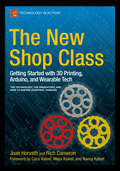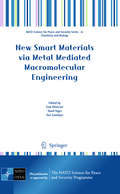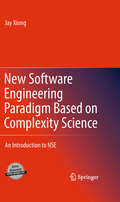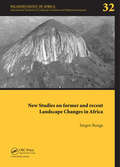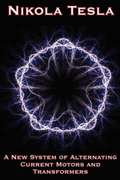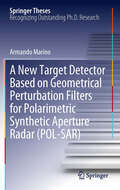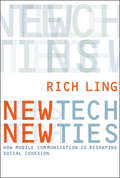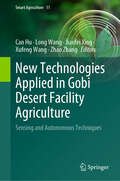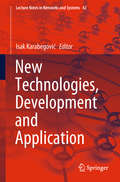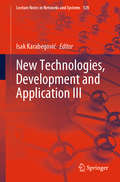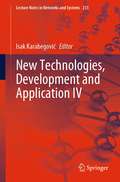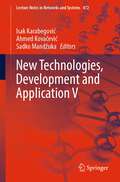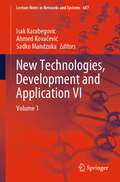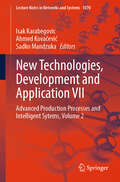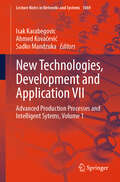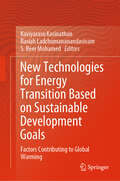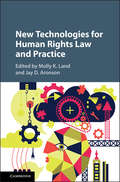- Table View
- List View
The New Shop Class
by Joan Horvath Rich CameronThe New Shop Class connects the worlds of the maker and hacker with that of the scientist and engineer. If you are a parent or educator or a budding maker yourself, and you feel overwhelmed with all of the possible technologies, this book will get you started with clear discussions of what open source technologies like 3D printers, Arduinos, robots and wearable tech can really do in the right hands. Written by real "rocket scientist" Joan Horvath, author of Mastering 3D Printing, and 3D printing expert Rich Cameron (AKA whosawhatsis), The New Shop Class is a friendly, down-to-earth chat about how hands-on making things can lead to a science career. Get practical suggestions about how to use technologies like 3D printing, Arduino, and simple electronics Learn how to stay a step ahead of the young makers in your life and how to encourage them in maker activities Discover how engineers and scientists got their start, and how their mindsets mirror that of the maker What you'll learn What all of the big "maker" technologies are, what they can do, and how to get more information Why scientists, citizen scientists, and makers do what they do -- and how they do what they do Why breaking things is as important as making things How portrayals of science differ from the real world How to encourage the young scientists and makers in your life, or become one yourself What scientists and makers can learn from each other Who this book is for Aspiring scientists, makers, teachers, students, and anyone who wants a guide to the vast and expanding world of makers and their tools and inventions. Table of Contents Front Matter: Featuring a Foreword by Coco Kaleel, Mosa Kaleel, and Nancy Kaleel Part 1. The Technologies Chapter 1. 21st Century Shop Teacher Chapter 2. Arduino, Raspberry Pi, and Programming Physical Things Chapter 3. 3D Printing Chapter 4. Robots, Drones, and Other Things that Move Part 2. Applications and Communities Chapter 5. Makerspaces and Hackerspaces Chapter 6. Citizen Science and Open Source Labs Chapter 7. Cosplay, Wearable Tech and the Internet of Things Chapter 8. Circuits and Programming for Kids Chapter 9. Open Source Mindset and Community Chapter 10. Creating Female Makers Chapter 11. Making at a Community College and Beyond Part 3. How Scientists Get Started Chapter 12. Becoming a Scientist Chapter 13. How Do Scientists Think? Chapter 14. What Do Scientists Do All Day? Part 4. Tying It All Together Chapter 15. Learning by Iterating Chapter 16. Learning Science by Making Chapter 17. What Scientists Can Learn from Makers Appendix: Links
New Smart Materials via Metal Mediated Macromolecular Engineering
by Ezat Khosravi Yuri Savelyev Yusuf YagciControl over macromolecular architecture and resulting material properties has been a central goal of polymer chemistry. There has been much interest in developing new synthetic routes to prepare smart materials with novel compositions and topologies for various applications. The considerable progress in the metal mediated macromolecular engineering over the past decade has had a major impact on the development of well-defined macromolecular architectures and the synthesis of smart materials. Particularly, remarkable strong developments have been observed for the synthesis of smart materials via four metal mediated macromolecular engineering techniques; Anionic, ROMP, ATRP and Click Chemistry. These materials have found uses in advanced microelectronics, technical and biomedical applications as well as in chemical sensors applications. This book is comprised of 27 chapters written by leading scientists from NATO and Partner Countries who have greatly contributed in the area of Anionic, ROMP, ATRP and Click Chemistry. It highlights the fundamental aspects and recent developments of these four powerful techniques and evaluate their potential in the syntheses of smart materials from complex structures (grafts, brushes, dendrimers, etc.) to nanostructures (self-assembly, nano-size, etc) for a wide range of applications. The book reports on the synthesis of a wide range of well-defined complex polymeric systems such as thermoresponsive smart polymers, star copolymers, biocompatible polymers, amphipilic smart nano structured, conducting polymers, self assembled polymers, and hyperbranced polymers.
New Software Engineering Paradigm Based on Complexity Science
by Jay XiongThis book describes a complete revolution in software engineering based on complexity science through the establishment of NSE - Nonlinear Software Engineering paradigm which complies with the essential principles of complexity science, including the Nonlinearity principle, the Holism principle, the Complexity Arises From Simple Rules principle, the Initial Condition Sensitivity principle, the Sensitivity to Change principle, the Dynamics principle, the Openness principle, the Self-organization principle, and the Self-adaptation principle. The aims of this book are to offer revolutionary solutions to solve the critical problems existing with the old-established software engineering paradigm based on linear thinking and simplistic science complied with the superposition principle, and make it possible tohelp software development organizations double their productivity, halve their cost, and remove 99% to 99.99% of the defects in their software products, and efficiently handle software complexity, conformity, visibility, and changeability. It covers almost all areas in software engineering. The tools NSE_CLICK- an automatic acceptance testing platform for outsourcing (or internally developed) C/C++ products, and NSE_CLICK_J - an automatic acceptance testing platform for outsourcing (or internally developed) Java products are particularly designed for non-technical readers to view/review how the acceptance testing of a software product developed with NSE can be performed automatically, and how the product developed with NSE is truly maintainable at the customer site.
The New Starting Right With Bees: A Beginner's Handbook on Beekeeping
by Kim Flottum Kathy SummersThis book is a culmination of nearly 40 years of work by the editors and staff of Gleanings in the Bee Culture. It's primary intent is as a learning tool for beginning beekeepers, but it is an exceptional source of information for anyone interested in the fascinating world of honey bees. This book covers every aspect of introductory beekeeping and honey bee biology--including seasonal management, equipment used, harvesting and marketing hive products, honey bee communication and beekeeping social skills. Beekeeping can become a hobby, a part-time or full-time occupation, but whatever your eventual involvement, this book will make beekeeping easier, since you are Starting Right with Bees.
New Studies on Former and Recent Landscape Changes in Africa: Palaeoecology of Africa 32 (Palaeoecology of Africa)
by Jürgen RungeVolume 32 (2013) of the internationally recognized and acclaimed yearbook seriesPalaeoecology of Africa publishes 9 new interdisciplinary scientific papers on former and recent landscape evolution and on past environments of the African continent (e.g. climate change, vegetation dynamics and growing impact of humans on ecosystems). These papers
A New Swing-Contract Design for Wholesale Power Markets (IEEE Press Series on Power and Energy Systems)
by Leigh TesfatsionProvides comprehensive information on swing contracts for flexible reserve provision in wholesale power markets This book promotes a linked swing-contract market design for centrally-managed wholesale power markets to facilitate increased reliance on renewable energy resources and demand-side participation. The proposed swing contracts are firm or option two-part pricing contracts permitting resources to offer the future availability of dispatchable power paths (reserve) with broad types of flexibility in their power attributes. A New Swing-Contract Design for Wholesale Power Markets begins with a brief introduction to the subject, followed by two chapters that cover: general goals for wholesale power market design; history, operations, and conceptual concerns for current U.S. RTO/ISO-managed wholesale power markets; and the relationship of the present study to previous swing-contract research. The next eight chapters cover: a general swing-contract formulation for centrally-managed wholesale power markets; illustrative swing-contract reserve offers; inclusion of reserve offers with price swing; inclusion of price-sensitive reserve bids; and extension to a linked collection of swing-contract markets. Operations in current U.S. RTO/ISO-managed markets are reviewed in the following four chapters, and conceptual and practical advantages of the linked swing-contract market design are carefully considered. The book concludes with an examination of two key issues: How might current U.S. RTO/ISO-managed markets transition gradually to a swing-contract form? And how might independent distribution system operators, functioning as linkage entities at transmission and distribution system interfaces, make use of swing contracts to facilitate their participation in wholesale power markets as providers of ancillary services harnessed from distribution-side resources? In summary, this title: Addresses problems with current wholesale electric power markets by developing a new swing-contract market design from concept to practical implementation Provides introductory chapters that explain the general principles motivating the new market design, hence why a new approach is required Develops a new type of swing contract suitable for wholesale power markets with increasing reliance on renewable energy and active demand-side participation A New Swing-Contract Design for Wholesale Power Markets is an ideal book for electric power system professionals and for students specializing in electric power systems.
A New System of Alternating Current Motors and Transformers and Other Essays
by Nikola TeslaNikola Tesla was a genius who revolutionized how the world looks at electricity. During college his professors explained that it was impossible to design an engine without commutators or brushes. Tesla was unconvinced that such was necessary or even particularly desirable. It was then that Tesla began his work on the rotating field motor that ultimately gave birth to the modern age. In May of 1888, Tesla delivered his lecture "A New System of Alternating Current Motors and Transformers" before The American Institute of Electrical Engineers and the world has never been the same.
A New Target Detector Based on Geometrical Perturbation Filters for Polarimetric Synthetic Aperture Radar (Springer Theses)
by Armando MarinoThis thesis presents a groundbraking methodology for the radar international community. The detection approach introduced, namely perturbation analysis, is completey novel showing a remarkable capability of thinking outside the box. Perturbation analysis is able to push forward the performance limits of current algorithms, allowing the detection of targets smaller than the resolution cell and highly embedded in clutter. The methodology itself is extraordinary flexibe and has already been used in two other large projects, funded by the ESA (European Space Agency): M-POL for maritime surveillance, and DRAGON-2 for land classification with particular attention to forests. This book is a perfectly organised piece of work where every detail and perspective is taken into account in order to provide a comprehensive vision of the problems and solutions.
New Tech, New Ties
by Rich LingThe message of this book is simple: the mobile phone strengthens social bonds among family and friends. With a traditional land-line telephone, we place calls to a location and ask hopefully if someone is "there"; with a mobile phone, we have instant and perpetual access to friends and family regardless of where they are. But when we are engaged in these intimate conversations with absent friends, what happens to our relationship with the people who are actually in the same room with us? In New Tech, New Ties,Rich Ling examines how the mobile telephone affects both kinds of interactions--those mediated by mobile communication and those that are face to face. Ling finds that through the use of various social rituals the mobile telephone strengthens social ties within the circle of friends and family--sometimes at the expense of interaction with those who are physically present--and creates what he calls "bounded solidarity." Ling argues that mobile communication helps to engender and develop social cohesion within the family and the peer group. Drawing on the work of Emile Durkheim, Erving Goffman, and Randall Collins, Ling shows that ritual interaction is a catalyst for the development of social bonding. From this perspective, he examines how mobile communication affects face-to-face ritual situations and how ritual is used in interaction mediated by mobile communication. He looks at the evidence, including interviews and observations from around the world, that documents the effect of mobile communication on social bonding and also examines some of the other possibly problematic issues raised by tighter social cohesion in small groups.
New Tech, New Ties: How Mobile Communication Is Reshaping Social Cohesion (The\mit Press Ser.)
by Richard LingHow cell phones and mobile communication may in many cases strengthen social cohesion.The message of this book is simple: the mobile phone strengthens social bonds among family and friends. With a traditional land-line telephone, we place calls to a location and ask hopefully if someone is “there”; with a mobile phone, we have instant and perpetual access to friends and family regardless of where they are. But when we are engaged in these intimate conversations with absent friends, what happens to our relationship with the people who are actually in the same room with us? In New Tech, New Ties, Rich Ling examines how the mobile telephone affects both kinds of interactions—those mediated by mobile communication and those that are face to face. Ling finds that through the use of various social rituals the mobile telephone strengthens social ties within the circle of friends and family—sometimes at the expense of interaction with those who are physically present—and creates what he calls “bounded solidarity.” Ling argues that mobile communication helps to engender and develop social cohesion within the family and the peer group. Drawing on the work of Emile Durkheim, Erving Goffman, and Randall Collins, Ling shows that ritual interaction is a catalyst for the development of social bonding. From this perspective, he examines how mobile communication affects face-to-face ritual situations and how ritual is used in interaction mediated by mobile communication. He looks at the evidence, including interviews and observations from around the world, that documents the effect of mobile communication on social bonding and also examines some of the other possibly problematic issues raised by tighter social cohesion in small groups.
New Techniques in Digital Holography
by Pascal PicartA state of the art presentation of important advances in the field of digital holography, detailing advances related to fundamentals of digital holography, in-line holography applied to fluid mechanics, digital color holography, digital holographic microscopy, infrared holography, special techniques in full field vibrometry and inverse problems in digital holographyspectives in 3-color holography applied to solid mechanics and fluid mechanics. Especially, a comparison between Michelson interferometer and interferometer using Wollaston prisms will be discussed. Chapter 4 is devoted to special techniques in holographic microscopy, with use of partial spatially coherent light sources; the use of a reduced coherence source is of interest for reducing the measurement noise; typical applications are detailed. Chapter 5 is devoted to applications of holographic microscopy in neurosciences. Chapter 6 presents digital holography in the infrared domain. Technology related to sensors and light sources are presented and digital holographic infrared interferometry is detailed and applied to high amplitude displacements of industrial aeronautic structures. Examples in NDT (non destructive testing) are also provided. Chapter 7 of the book, aims at presenting new techniques in the field of vibration measurement; especially, techniques based on high speed and ultimate sensitivity are described. Examples related to life sciences are discussed. Chapter 8 discusses about inverse problems in digital holography and demonstrates how a priori knowledge can be used to recover full information of the object scene even when recording is sparse.
New Technologies and Developments in Unmanned Systems: Proceedings of the International Symposium on Unmanned Systems and The Defense Industry 2022 (Sustainable Aviation)
by T. Hikmet Karakoc Soledad Le Clainche Xin Chen Alper Dalkiran Ali Haydar ErcanUnmanned systems are one of the fastest-growing and widely developing technologies in the world, offering many possibilities for a variety of research fields. This book comprises the proceedings of the 2022 International Symposium on Unmanned Systems and the Defense Industry (ISUDEF), a multi-disciplinary conference on a broad range of current research and issues in areas such as autonomous technology, unmanned aircraft technologies, avionics, radar systems, air defense, aerospace robotics and mechatronics, and aircraft technology design. ISUDEF allows researchers, scientists, engineers, practitioners, policymakers, and students to exchange information, present new technologies and developments, and discuss future direction, strategies, and priorities in the field of autonomous vehicles and unmanned aircraft technologies.
New Technologies Applied in Apple Production: Sensing and Autonomous Systems (Smart Agriculture #10)
by Yande Liu Liling Yang Yinyan Shi Guantian Wang Dazhou Zhu Zhao ZhangThis book focuses on state-of-the-art sensing and automation technologies for apple production, which provides innovative knowledge on imaging processing, AI algorithms, sensing techniques, non-destructive detection, and robotics. It falls into the area of applied science, more specifically engineering. This book, including a total of seven chapters, provides undergraduates or graduate take-away knowledge for autonomous apple production, which include but not limited to, apple harvest robotics, autonomous pollination, fruit quality detection, and postharvest infield sorting. A major innovative for this book is that it provides case studies for readers’ easy understanding. The incentive behind this book is to provide readers the latest, systematic, comprehensive new technologies for apple production.
New Technologies Applied in Gobi Desert Facility Agriculture: Sensing and Autonomous Techniques (Smart Agriculture #11)
by Can Hu Long Wang Jianfei Xing Xufeng Wang Zhao ZhangThis book adopts a cultivation technique using yellow sand substrate in the desert, making agricultural production possible. In Gobi Desert around the world, it is usually not suitable for agricultural production. However, through solar greenhouse facility technology, agricultural production can be achieved in the Gobi Desert. Due to labor shortage, coupled with high labor cost, facility mechanization plays an important role in Gobi Desert agricultural production. Currently, there is no book describing the mechanization technology progress in Gobi Desert production. This book provides researchers, especially graduates, tips for Gobi Desert facility agriculture and agricultural production terms of self-propelled trenching and film covering machine, seedling transplanting machinery, water and fertilizer integration system, and spraying mechanisms. All these very innovative technologies have been developed, and some have been commercially applied for Gobi Desert agricultural production. This book will benefit researchers, especially the newbies by providing cutting-edge knowledge, for those who are interested in facility agricultural, especially in Gobi Desert production mechanization.
New Technologies, Development and Application (Lecture Notes in Networks and Systems #42)
by Isak KarabegovićThe papers included in this book were presented at the International Conference “New Technologies, Development and Application,” which was held at the Academy of Sciences and Arts of Bosnia and Herzegovina in Sarajevo, Bosnia and Herzegovina on 28th–30th June 2018. The book covers a wide range of technologies and technical disciplines including complex systems such as: Robotics, Mechatronics Systems, Automation, Manufacturing, Cyber-Physical Systems, Autonomous Systems, Sensors, Networks, Control Systems, Energy Systems, Automotive Systems, Biological Systems, Vehicular Networking and Connected Vehicles, Effectiveness and Logistics Systems, Smart Grids, Nonlinear Systems, Power Systems, Social Systems, and Economic Systems.
New Technologies, Development and Application III (Lecture Notes in Networks and Systems #128)
by Isak KarabegovićThis proceedings book features papers presented at the International Conference on New Technologies, Development and Application, held at the Academy of Sciences and Arts of Bosnia and Herzegovina in Sarajevo on 25th–27th June 2020. It covers a wide range of future technologies and technical disciplines, including complex systems such as Industry 4.0; patents in Industry 4.0; robotics; mechatronics systems; automation; manufacturing; cyber-physical and autonomous systems; sensors; networks; control; energy and renewable energy sources; automotive and biological systems; vehicular networking and connected vehicles; effectiveness and logistics systems; smart grids; nonlinear systems; power; social and economic systems; education; and IoT. The book focuses on the Fourth Industrial Revolution “Industry 4.0,” in which implementation will improve many aspects of human life in all segments and lead to changes in business paradigms and production models. Further, new business methods are emerging, transforming production systems, transport, delivery, and consumption, which need to be monitored and implemented by every company involved in the global market.
New Technologies, Development and Application IV (Lecture Notes in Networks and Systems #233)
by Isak KarabegovićThis book features papers focusing on the implementation of new and future technologies, which were presented at the International Conference on New Technologies, Development, and Application, held at the Academy of Science and Arts of Bosnia and Herzegovina in Sarajevo on June 24–26, 2021. It covers a wide range of future technologies and technical disciplines, including complex systems such as Industry 4.0; patents in industry 4.0; robotics; mechatronics systems; automation; manufacturing; cyber-physical and autonomous systems; sensors; networks; control, energy, renewable energy sources; automotive and biological systems; vehicular networking and connected vehicles; effectiveness and logistics systems; smart grids; nonlinear systems; power, social and economic systems; education; and IoT. The book New Technologies, Development and Application III is oriented toward Fourth Industrial Revolution “Industry 4.0, ”implementation which improves many aspects of human life in all segments and leads to changes in business paradigms and production models. Further, new business methods are emerging and transforming production systems, transport, delivery, and consumption, which need to be monitored and implemented by every company involved in the global market.
New Technologies, Development and Application V (Lecture Notes in Networks and Systems #472)
by Isak Karabegović Ahmed Kovačević Sadko MandžukaThis book features papers focusing on the implementation of new and future technologies, which were presented at the International Conference on New Technologies, Development and Application, held at the Academy of Science and Arts of Bosnia and Herzegovina in Sarajevo on 23rd–25th June 2022. It covers a wide range of future technologies and technical disciplines, including complex systems such as industry 4.0; patents in industry 4.0; robotics; mechatronics systems; automation; manufacturing; cyber-physical and autonomous systems; sensors; networks; control, energy, renewable energy sources; automotive and biological systems; vehicular networking and connected vehicles; intelligent transport, effectiveness and logistics systems, smart grids, nonlinear systems, power, social and economic systems, education, IoT. The book New Technologies, Development and Application V is oriented towards Fourth Industrial Revolution “Industry 4.0”, in which implementation will improve many aspects of human life in all segments and lead to changes in business paradigms and production models. Further, new business methods are emerging, transforming production systems, transport, delivery and consumption, which need to be monitored and implemented by every company involved in the global market.
New Technologies, Development and Application VI: Volume 1 (Lecture Notes in Networks and Systems #687)
by Isak Karabegovic Ahmed Kovačević Sadko MandzukaThis book features papers focusing on the implementation of new and future technologies, which were presented at the International Conference on New Technologies, Development and Application, held at the Academy of Science and Arts of Bosnia and Herzegovina in Sarajevo on 22–24 June 2023. It covers a wide range of future technologies and technical disciplines, including complex systems such as Industry 4.0; patents in industry 4.0; robotics; mechatronics systems; automation; manufacturing; cyber-physical and autonomous systems; sensors; networks; control, energy, and renewable energy sources; automotive and biological systems; vehicular networking and connected vehicles; effectiveness and logistics systems, smart grids, nonlinear systems, power, social and economic systems, education, and IoT. This book is oriented towards Fourth Industrial Revolution “Industry 4.0”, which implementation will improve many aspects of human life in all segments and lead to changes in business paradigms and production models. Further, new business methods are emerging, transforming production systems, transport, delivery, and consumption, which need to be monitored and implemented by every company involved in the global market.
New Technologies, Development and Application VI: Volume 2 (Lecture Notes in Networks and Systems #707)
by Ahmed Kovačević Isak Karabegovic Sadko MandzukaThis book features papers focusing on the implementation of new and future technologies, which were presented at the International Conference on New Technologies, Development and Application, held at the Academy of Science and Arts of Bosnia and Herzegovina in Sarajevo on 22–24 June 2023. It covers a wide range of future technologies and technical disciplines, including complex systems such as Industry 4.0; patents in industry 4.0; robotics; mechatronics systems; automation; manufacturing; cyber-physical and autonomous systems; sensors; networks; control, energy, and renewable energy sources; automotive and biological systems; vehicular networking and connected vehicles; effectiveness and logistics systems, smart grids, nonlinear systems, power, social and economic systems, education, and IoT. This book is oriented towards Fourth Industrial Revolution “Industry 4.0”, which implementation will improve many aspects of human life in all segments and lead to changes in business paradigms and production models. Further, new business methods are emerging, transforming production systems, transport, delivery, and consumption, which need to be monitored and implemented by every company involved in the global market.
New Technologies, Development and Application VII: Advanced Production Processes and Intelligent Sytems, Volume 2 (Lecture Notes in Networks and Systems #1070)
by Ahmed Kovačević Isak Karabegovic Sadko MandzukaThis book features papers focusing on the implementation of new and future technologies, which were presented at the International Conference on New Technologies, Development and Application—Advanced Production Processes and Intelligent Systems held at the Academy of Science and Arts of Bosnia and Herzegovina in Sarajevo on 20–22 June 2024. It covers a wide range of future technologies and technical disciplines, including complex systems such as Industry 4.0; robotics; mechatronics systems; automation; manufacturing; cyber-physical and autonomous systems; sensors; networks; control, energy, renewable energy sources; automotive and biological systems; vehicular networking and connected vehicles; and intelligent transport, effectiveness and logistics systems, smart grids, nonlinear systems, power, social and economic systems, education, and IoT. The book New Technologies, Development and Application VII is oriented toward Fourth Industrial Revolution “Industry 4.0”, which implementation will improve many aspects of human life in all segments and lead to changes in business paradigms and production models. Further, new business methods are emerging, transforming production systems, transport, delivery, and consumption, which need to be monitored and implemented by every company involved in the global market.
New Technologies, Development and Application VII: Advanced Production Processes and Intelligent Sytems, Volume 1 (Lecture Notes in Networks and Systems #1069)
by Ahmed Kovačević Isak Karabegovic Sadko MandzukaThis book features papers focusing on the implementation of new and future technologies, which were presented at the International Conference on New Technologies, Development and Application—Advanced Production Processes and Intelligent Systems held at the Academy of Science and Arts of Bosnia and Herzegovina in Sarajevo on 20–22 June 2024. It covers a wide range of future technologies and technical disciplines, including complex systems such as Industry 4.0; robotics; mechatronics systems; automation; manufacturing; cyber-physical and autonomous systems; sensors; networks; control, energy, renewable energy sources; automotive and biological systems; vehicular networking and connected vehicles; and intelligent transport, effectiveness and logistics systems, smart grids, nonlinear systems, power, social and economic systems, education, and IoT. The book New Technologies, Development and Application VII is oriented toward Fourth Industrial Revolution “Industry 4.0”, which implementation will improve many aspects of human life in all segments and lead to changes in business paradigms and production models. Further, new business methods are emerging, transforming production systems, transport, delivery, and consumption, which need to be monitored and implemented by every company involved in the global market.
New Technologies for Electrochemical Applications
by Mu. Naushad Saravanan Rajendran Abdullah M. Al-EniziThe field of electrochemistry is exploring beyond its basic principles to innovation. New Technologies for Electrochemical Applications presents advancements in electrochemical processes, materials, and technology for electrochemical power sources such as batteries, supercapacitors, fuel cells, hydrogen storage and solar cells. It also examines various environmental applications such as photo electrochemistry, photosynthesis, and coating. Organized to give readers an overview of the current field in electrochemical applications, this book features a historical timeline of advancements and chapters devoted to the topics of organic material and conducting polymers for electrochemical purposes. Established experts in the field detail state-of-the-art materials in biosensors, immunosensors, and electrochemical DNA. This edited reference is a valuable resource for graduate and post-graduate students, and researchers in disciplines such as chemistry, physics, electrical engineering and materials science.
New Technologies for Energy Transition Based on Sustainable Development Goals: Factors Contributing to Global Warming
by Kaviyarasu Kasinathan Rasiah Ladchumananandasivam S. Beer MohamedThis book describes numerous issues and brings an improved understanding of a key agenda item for the sustainable development goals (SDGs). The SDGs represent an urgent call for action by all countries, developed and developing, working jointly within the global community. A few of the industries it supports include food processing, energy, biomedical science, space research, drug delivery, and biosensors. This book highlights multidisciplinary solutions for protecting the environment while ensuring the future of our planet. The book mainly targets undergraduates, postgraduates, and doctoral students who are working in materials science and researchers across the world working in interdisciplinary research for climate change for sustainable growth.
New Technologies for Human Rights Law and Practice
by Jay D. Aronson Molly K. LandNew technological innovations offer significant opportunities to promote and protect human rights. At the same time, they also pose undeniable risks. In some areas, they may even be changing what we mean by human rights. The fact that new technologies are often privately controlled raises further questions about accountability and transparency and the role of human rights in regulating these actors. This volume – edited by Molly K. Land and Jay D. Aronson – provides an essential roadmap for understanding the relationship between technology and human rights law and practice. It offers cutting-edge analysis and practical strategies in contexts as diverse as autonomous lethal weapons, climate change technology, the Internet and social media, and water meters. This title is also available as Open Access.
